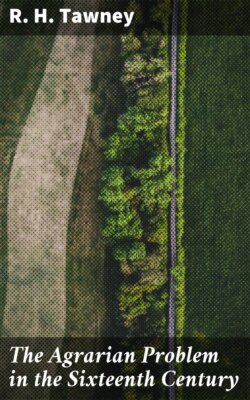Читать книгу The Agrarian Problem in the Sixteenth Century - R. H. Tawney - Страница 10
На сайте Литреса книга снята с продажи.
Table I
Оглавление| Total | Freeholders | Customary Tenants | Leaseholders | Uncertain | |
| Northumberland, six manors | 474 | 26 | 436 | 12 | |
| Lancashire, seven manors, and lands belonging to Cockers and Abbey | 1280 | 217 | 451 | 334[62] | 278 |
| Total | 1754 | 243 | 887 | 334 | 346 |
| (13.8%) | (50.5%) | (19.04%) | (15%) | ||
| Staffordshire, six manors | 356 | 44 | 272 | 23 | 17 |
| Leicestershire, nine manors | 618 | 134 | 311 | 124 | 49 |
| Northamptonshire, seven manors | 531 | 100 | 355 | 66 | 10 |
| Total | 1505 | 278 | 938 | 213 | 76 |
| (18.1%) | (62.3%) | (14.2%) | (5%) | ||
| Norfolk, twenty-five manors | 1011[63]] | 316 | 596 | 53 | 50 |
| Suffolk, fourteen manors | 353 | 176 | 146 | 25 | 6 |
| Total | 1364[63] | 492 | 742 | 78 | 56 |
| (36%) | (54.3%) | (5.7%) | (4.1%) | ||
| Wiltshire, Somerset, and Devonshire, thirty-two manors | 1102 | 149 | 817 | 136 | |
| Hampshire, two manors | 259 | 8 | 251 | ||
| Ten other manors in the south of England | 219 | 43 | 158 | 12 | 6 |
| Total | 1580 | 200 | 1226 | 148 | 6 |
| (12.6%) | (77.2%) | (9.3%) | (0.3%) | ||
| Grand Total | 6203[63] | 1213 | 3793 | 785 | 416 |
| (19.5%) | (61.1%) | (12.6%) | (6.7%) |
Yet there is one point emerging from these figures of which the explanation can hardly be in doubt. It will be noticed that in Norfolk and Suffolk combined the proportion of freeholders is about double what it is in the country as a whole. In the former county they form more than one-third of all the landholders, and in the latter they are almost equal to the other two classes together. The number of peasant proprietors in Suffolk is indeed quite exceptional, and is one of the most remarkable facts revealed by the surveys, drawing an unmistakable line between the land tenure of the east and that of the south-west and the northern border. In Wiltshire and Northumberland it is not uncommon to find villages where no freeholders at all are recorded. In Norfolk and Lancashire it is the exception for them to be in a majority. But on half the Suffolk manors summarised above they are the largest class represented, and on some they stand to the other landholders in a proportion of two, three, and even four to one. Is it fanciful, one may ask, to turn from the sixteenth century to the dim beginnings of things, to that first and greatest survey in which the land of England was described so that not an ox or an acre escaped valuation, and in which, before freehold tenure had been hammered into any precise legal shape, Suffolk and Norfolk abounded more than all other counties in liberi homines and sochemanni? Though a longer time separates these documents from Domesday[64] than separates them from us, perhaps it is not altogether fanciful. Rural life, except for one great catastrophe, has been very permanent. Unlike rural life to-day, it has been most permanent in its lower ranges. How ever often manors may have changed hands, there has been little to break the connection with the soil of peasants whose title is good, no change at all comparable to the buying out of small freeholders which took place in the eighteenth and nineteenth centuries. It may well be that the main outlines of the social system which the Domesday commissioners found already laid in the east of England crop out again after the lapse of between four and five hundred years. It may well be that Suffolk is a county of small freeholders in the days of Henry VIII. and Elizabeth, because it was a county of free men and socmen in the days of William I.
